I flew over 600km - without an engine.
It took a while - almost 8 hours - and was the culmination of many years of training. My trusty LAK-12 with its 20.5m wingspan felt as if it could just keep flying and flying - but the sun was setting and it was time to head home.
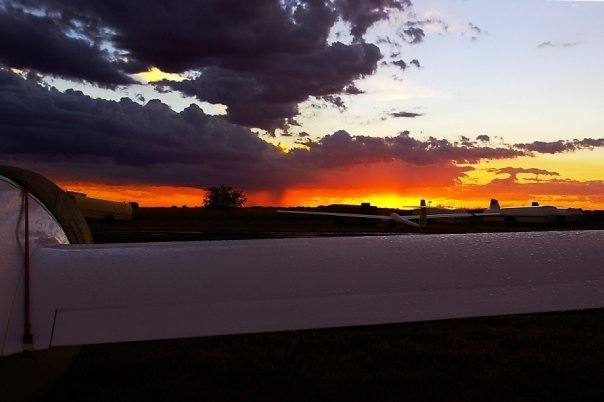
My flight started eight years previously when I joined the Goldfields Gliding Club. The club is located in the rich agricultural area of South Africa called the Free State. Perfect area for thermal flying especially in the summer months. The club is small but has a comprehensive fleet of training as well as competition ready sailplanes. These include K-7, ASK-13, ASK-21, ASK-23, ASW-19 and ASW-20 types. The natural progression is to start flying the K-7 and ASK-13 gliders with the instructors till going solo in the K-7 after typically between 30 and 50 flights.
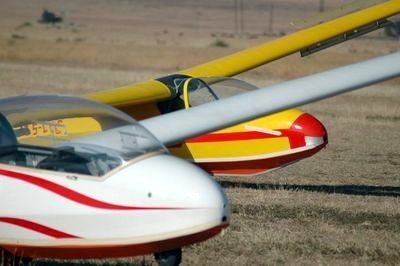
Goldfields Gliding Club K-7 and ASK-13 sailplanes
From there, progress to the more advanced gliders is related to number of launches and hours in the air.
Exams are written and flight tests conducted to ensure competence before receiving the glider pilots licence. Along with the license, there are also a series of (Fédération Aéronautique Internationale) FAI badges which pilots strive for. These include the Silver C (awarded after a flight of 5 hours as well as 1000m height gain and a short cross-country flight), the Gold C (300km cross-country flight and 3000m height gain) and the Diamonds (including the 500km diamond). Further awards are given for 750km, 1000km and 1250km flights. Enough incentive to keep pilots pushing their personal boundaries. And then there are the competitions too - races held over distances between 200 and 500km with the top pilots exceeding 150km/h average speed over the task distance.
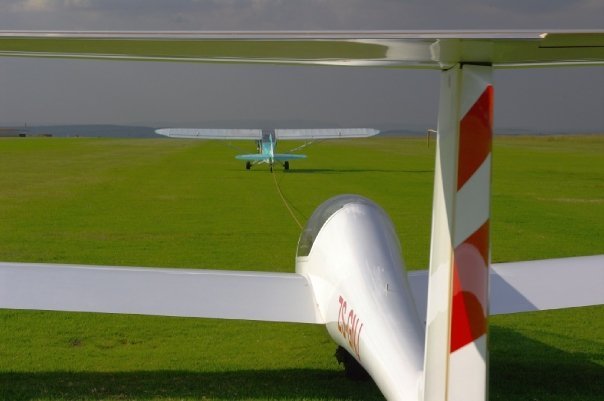
Sailplane about to be launched behind a tug plane
So with a licence, my own sailplane, some competition experience and a Gold C with two diamonds (300km goal flight and 500km flight), I thought it was time to focus on some serious distance flying. Every year camps are held in various locations in the Southern African summer. These include Gariep, Douglas and Bloemfontein in South Africa as well as Pokweni and Bitterwasser in Namibia. These camps are located in the drier parts of the country and run from mid-November into February. Pilots from all over the world (predominantly Europe) ship their sailplanes out in containers and then use the fantastic summer flying weather to achieve their personal, as well as National and even World records. Many flights exceeding 1000km have been achieved from these locations over the last 20 years.
I was living about 300km north east of Gariep and chose to go flying there for a week.
Although the distance was not that far, the climatic conditions are totally different. Gariep is located in the Karoo, a massive semi-desert which dominates the heartland of South Africa. Certainly none of the unending maize fields of the Free State with numerous choices to land-out. Jip - that is the challenge with soaring - there is no certainty the flight will end at the airfield where it started, or even at any airfield. Landings in farmers fields are a common occurrence, especially during competition flying where an out-landing will score more points than abandoning a task and heading back to the home airfield. My personal goal was to achieve a 750km flight.
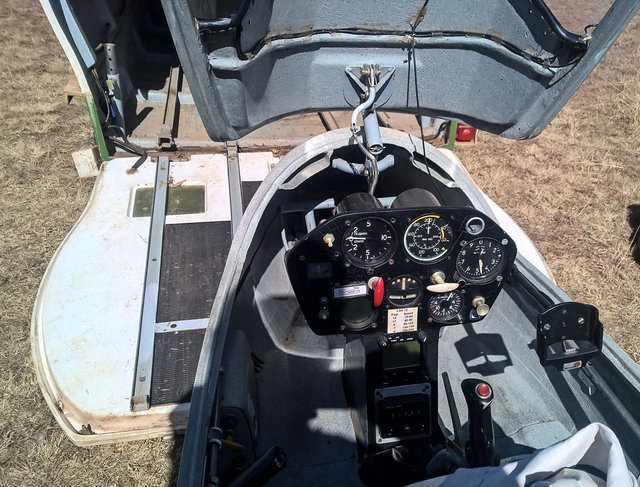
LAK-12 Cockpit
The week started with a 500km flight out to Victoria West and back.
A nice little warm-up, to get a feel for the countryside I would be flying over, and observing how the experienced European pilots used the conditions.
My LAK-12 has long white wings - but was one of the smaller sailplanes there that week. The ASH-25, Nimbus 4 and ASW-22 all have wingspans exceeding 27m. In soaring - long wings mean better (lift-to-drag) L/D ratios. This is one of a sailplanes main performance measures. The LAK-12 has an L/D ratio of 1:48 which means in absolutely still air and flying at its optimum speed, the sailplane will fall 1m for every 48m it flies. Not too shabby considering the airfoil shapes used on the LAK-12 date back to the early 1970s. The latest sailplanes have L/D ratios in excess of 1:60 - and these are achieved at far higher speeds (vital for racing). The advantage of long wings is really noticeable in weaker European conditions. In the strong thermal conditions of Southern Africa, gliders with wingspans of 18-22m can be faster (with higher wing-loadings and less drag - a couple of terms glider pilots discuss at length over the beers after flights) and thus fly further.
The weather the following day was not as strong.
The 'strength' of the day is related to the thermal strengths which give an idea of how long it will take to climb back up to altitude. Thermals are convection currents in the atmosphere which glider pilots use to gain altitude. A sailplane (or glider - the two words are interchangeable) is always falling in relation to the air around it - jip - gravity sucks. The trick is to find air rising faster than the sailplane is falling. So it was a local flight of about 320km. The next day the weather was really not favorable and so the day was spent with the family exploring the area around Gariep and the Gariep Dam (the largest dam in South Africa) and the whole are is very picturesque. A 450km flight the following day, along with rising confidence, meant for the final day I was ready for a personal record flight.
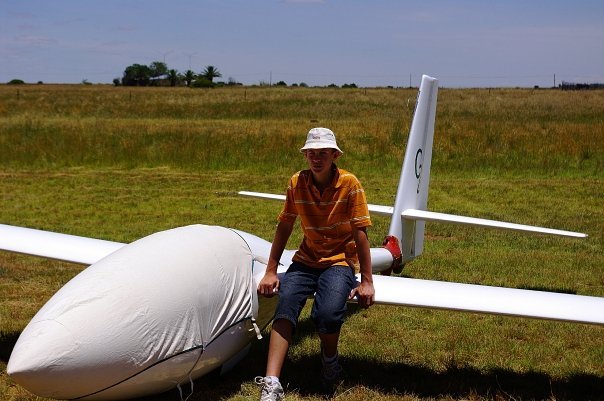
Long suffering crew on the wing of C2, my LAK-12
The big day started early.
Getting dressed with suitable loose fitting clothes. It can be pretty warm under the perspex canopy and the cockpit is cramped enough with a parachute that any restrictions want to be minimised. Comfortable shoes that are study enough to walk to the nearest road or farmhouse in case of an out-landing. A warm jacket in case of spending a long night by the sailplane waiting to be retrieved. Cell phone fully charged with a spare battery (not that there is much cell reception away from the main roads). Batteries for the LAK-12 instruments and radio fully charged, logger updated with a task for the day (750km) and two camel backs filled with isotonic drinks. Sweets and sun lotion packed and then it was off to the airfield with my crew (nephew). Long flights are not possible without a crew to organise a retrieve in case of an out-landing. They also useful for washing those long white wings. A sailplane must be spotless to perform at its optimum - so all the squashed bugs need to be washed off the wings are they are polished till they gleam. Gaps between the wings and the fuselage are taped closed as are the gaps between the wings and flaps/ailerons along with the rudder and elevator. Anything that disturbs the perfect airflow over the aircraft needs to be minimised because it creates drag. The wings of the LAK-12 were also filled with over 200 liters of water - dischargable ballast used on strong days to increase the inter-thermal speeds although a heavy glider climbs slower. Oxygen cylinder filled and oxygen system battery replaced.
Once my aircraft was prepared for the flight, I went to the briefing room.
All the pilots planning to fly attended a daily briefing session. What a mix of nationalities. Aspects like safety, weather, runways-in-use and launch times were discussed. I asked for an early launch because of my lofty plans for the day. The self-launching gliders would launch from a different runway from those needing to be tugged into the air behind the tug aircraft. These sailplanes have a small engine behind the cockpit which can be raised out of the fuselage. The engine is just powerful enough to allow the sailplane to take-off under its own power, and climb to a height sufficient to start using the thermals. They can also get the pilot home if the thermals die out while still too far away to glide back to the airfield. Most of the gliders coming from Europe for the camp were self-launching gliders (or fitted with an even smaller sustainer engine which whilst being too small to launch, it is enough to get the sailplane back home). These gliders do not need crews and trailers on standby which is important to those pilots travelling from far. The shipping of a sailplane with a trailer is substantially more than just the sailplane by itself.
The long train of sailplanes gets towed down to the runways behind cars.
They then get lined up in the take-off order and everyone waits around for the thermals to start forming. If a sailplane is launched whilst filled with water ballast, the water must be dumped before landing (this can be seen in the opening photo and appears as smoke trailing behind the sailplane). So the pilots want to be reasonably sure they can stay up before launching, or a lot of time could be wasted in re-filling the water ballast before the next launch. The one disadvantage of self-launching sailplanes is that they cannot carry the same amount of water ballast as conventional gliders (due to the weight of the engine and fuel). A sniffer glider is launched behind the Cessna 182 and its pilot reports that he is climbing straight after he releases from the tug aircraft. Suddenly there is a mad scramble to start launching all the sailplanes as quickly as possible. Between each sailplane launched behind the Cessna, two self-launching sailplanes take off on the other runway.
I am first to launch after the sniffer.
I release at 450m into weak lift and find it difficult to gain altitude. Two self-launchers join me and quickly move off to try find a stronger thermal. They are also battling to find stronger lift and so they keep their engines running. It appears that a large area of stable air that has moved into the area around the Gariep Dam. I slowly move away from the airfield towards the south. The lift is weak and very broken. I decide against dumping my water and landing and move towards the town of Colesburg about 40km south of the airfield. And keep getting lower and lower. The aircraft is sluggish and does not want to climb in the weak lift. I am down to 400m (just above the height a pilot will join the landing circuit) and over 20km from the airfield. There is a stud farm with a airstrip which would be a safe alternative landing place. The only way to stay up is to drop the water - the extra weight is now a liability and preventing me gaining altitude in the weak thermals. All thoughts of 750km are abandoned and the mission is just to stay airborne.
Lenticular clouds mark wave lift - the holy grail for soaring pilots.
They usually form in the lee of mountain ranges. I see some scattered clouds close by to the west which appear to be lenticular in nature. Out further to the west I can see cumulus clouds starting to form which indicate stronger thermals. Lenticular clouds require stable air whilst the cumulus clouds require unstable air. Very different forms of rising air. I radio the airfield and ask if wave lift is ever encountered in the Gariep area. They confirm its very rare in summer but sometimes it is encountered.
Decision time - stay by the safety of the gravel strip or head out to the west over very inhospitable terrain.
I see a couple of farms with small fields that could be safely landed on and decide its worth the risk. The sailplane is climbing better relieved of the extra weight and so I start making my way towards the closest lenticular cloud. Lift - it's weak but very smooth - I have found wave. I slowly climb at about 1.5 meters per second and start gaining altitude. 600 meters and then 800 meters. West and the cumulus are calling - so leave the area of wave under the first lenticular cloud and head to the next one. Slowly gaining altitude as I move from one area of wave to the next.
And then I am in gliding distance of the cumulus clouds.
So I leave the last farm with a landable field and head west. And then I hit the thermals. 3 meters per second and quickly climbing through 1500 meters above ground. The thermal strength is increasing - 4 meters per second. My focus shifts from the height above ground to altitude above sea level. 10 000 feet, 11 000 feet. Time to put on the oxygen cannula and turn on the system. 12 000 feet. Time to head west - always west. I am now flying over the second largest dam in South Africa, the Vanderkloof Dam. The terrain is very rugged with no safe landing areas, but as I climb towards 16 000 feet, an out-landing is furthermost from my mind. With the 750km task abandoned, the aim of the flight is to head as far west as possible. There is however controlled airspace blocking my route. Time to start speaking to air traffic control. They allow me to pass through the air route perpendicularly at 15 000 feet instead of descending below it. And so the flight passes as if in a dream. Each climb is higher than the previous one. Thermal strengths increase with average climbs exceeding 6 meters per second being experienced. I never drop below 10 000 feet and the oxygen gives a reassuring burst every second breath I take. The climbs start topping out above 17 000 feet when I am forced to descend below the next area of controlled airspace.
By now I am further west than I had ever been and it was time to return to Gariep. So turn the sailplane, keeping below another area of airspace till clear of it. Final two climbs of the day, back to 17 000 feet and then 18 000 feet. That is over 4km above the ground. The flight computer indicates I am over 150km from the airfield but almost have sufficient height to return with no further climbs. I then start my descent. As I fly I monitor my flight computer - slowing in rising air and speeding up in descending air. Flying close to the optimum glide speed at all times. This is called dolphining. The computer then indicates I am on final glide. I can safely make the airfield with sufficient height in reserve for unexpected areas of descending air (sink). For the first time since I put on the oxygen about 6 hours previously, I feel the system has stopped pulsing. I am below 10 000 feet and has automatically turned itself off. There are still large areas of rising air. I increase the speeds above the optimum speeds and move along a more southerly track to increase the overall distance of the flight.
The sun is now low on the horizon.
I turn directly towards the airfield still 40km away. The extra height gained with the dolphining flight can now be converted into extra speed. Arriving back over the airfield with too much height is wasted energy. The speed rises to above 170km/h. I can now see the airfield and still have sufficient height to accelerate to over 200km/h. Oh how I wish for the water now because that would have given the aircraft more potential energy, allowing faster gliding speeds for the same loss in height. I do my call to the airfield indicating I am 10km out - and accelerate to 250km/h - the red-line speed for the LAK-12 in smooth air. There is no conflicting traffic in the circuit so I am cleared to do a flypast over the airfield before landing. So, 250km/hour at about 20m above the ground before converting all the speed back into height to join the landing circuit.
The LAK-12 is finally on the ground.
My crew comes with the car to tow the sailplane back to the trailer, where it will be de-rigged for the long drive back home. Post flight analysis shows the flight was 634km and I was airborne for 7 hours and 55 minutes. The distance flown from the last climb to landing (final glide) was 172km. Although I did not achieve the planned 750km, the flight was still over 100km further than my previous longest flight. Time to stretch the stiff legs and have a long cold beer.
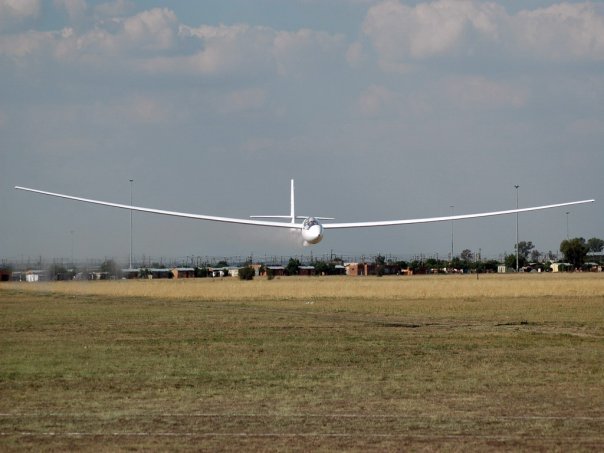
Awesome read, I'm a huge fan of paragliding and attempting to fly like a bird!!!!
Downvoting a post can decrease pending rewards and make it less visible. Common reasons:
Submit
Just so so awesome to fly using free energy
Downvoting a post can decrease pending rewards and make it less visible. Common reasons:
Submit
Awesome experience, props to both of you.
Downvoting a post can decrease pending rewards and make it less visible. Common reasons:
Submit
Thanks :-)
Downvoting a post can decrease pending rewards and make it less visible. Common reasons:
Submit
This article inspires my imagination, cool. I am curious, what is the current record for manned engineless flight distance?
Downvoting a post can decrease pending rewards and make it less visible. Common reasons:
Submit
In a sailplane - over 3000km. Two germans in the Andes - 15 hours in wave at altitudes over 5000m. Average speed 200km/h. And the altitude record is over 50 000 feet. That's higher than Boeing's fly - or even Concorde.
Downvoting a post can decrease pending rewards and make it less visible. Common reasons:
Submit
Wow! That is the best post ever!!
Downvoting a post can decrease pending rewards and make it less visible. Common reasons:
Submit